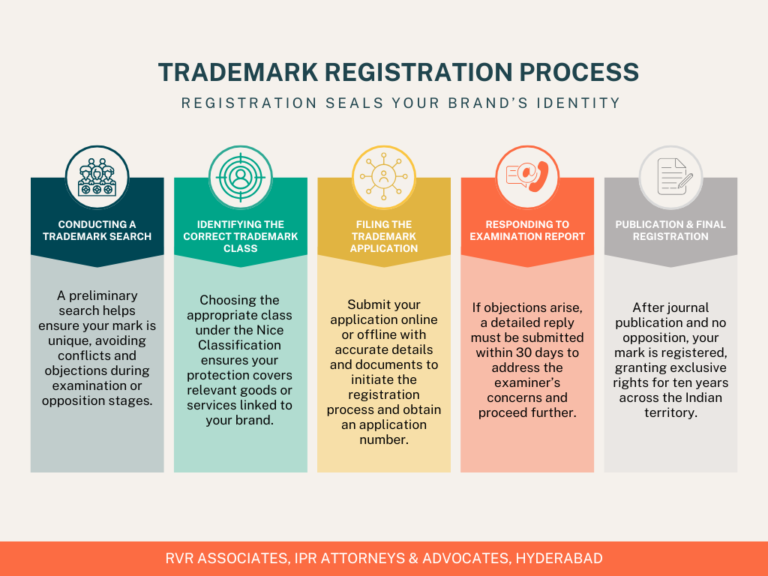
In today’s dynamic and innovation-driven commercial environment, securing brand identity is imperative, and trademark registration is an essential aspect that cannot be overlooked. A trademark serves not only as a representation of a business’s identity but also acts as a distinguishing factor for its goods or services in a competitive marketplace.
This article provides a comprehensive, step-by-step overview of the trademark registration process in India, enabling trademark owners to safeguard their brand with clarity and confidence.
What is a Trademark?
A trademark is any unique symbol, word, phrase, design, logo, or combination thereof that serves as a brand identifier. It provides a distinct identity to a product or service, distinguishing it from others in the same industry.
Once registered, a trademark becomes intellectual property, granting the owner exclusive rights to use it throughout India. These rights are governed by the Trade Marks Act, 1999.
It is important to note that India follows the “First-to-Use” principle, not “First-to-File.” This means that actual usage of a trademark holds primary significance in establishing ownership, while registration provides statutory protection and strengthens the legal enforceability of rights.
Who Can Apply for a Trademark in India?
As per Section 18 of Trademark Act, 1999, a Trademark registration in India may be initiated by any person or legal entity that owns or intends to use a mark in the course of trade.
Eligible applicants include:
- Individual entrepreneurs
- Startups and Small & Medium Enterprises (SMEs)
- Private and Public Limited Companies
- Partnership Firms and Limited Liability Partnerships (LLPs)
- Non-Profit Organizations
- Foreign entities engaged in business operations within India
These entities may apply either in their own name or through an authorised agent, such as a trademark attorney.
Documents Required for Trademark Registration in India
The following documents are generally required to initiate the process of trademark registration in India:
- Identity Proof of the Applicant – Such as Aadhaar Card, PAN Card, or Passport
- Address Proof – Including utility bills, rent agreement, or any government-issued document evidencing address
- Business Registration Proof – For legal entities, this may include the Certificate of Incorporation, Partnership Deed, or LLP Agreement
- Representation of the Trademark – A clear depiction of the mark/logo in JPEG format
- Power of Attorney – In cases where the application is being filed through a trademark attorney or agent
- User Affidavit – If the trademark is already in use, an affidavit supporting such prior usage may be required
It is advisable to ensure the accuracy and completeness of the documents to avoid delays or objections during the examination process.
Step-by-Step Process for Trademark Registration in India
Step 1: Trademark Search
Before adopting a business name or logo, it is advisable to conduct a trademark availability search on the IP India website. This ensures that the desired brand name or logo is not already registered, thereby minimizing the risk of objections or rejection during the registration process.
Step 2: Determining the Trademark Class
India follows the Nice Classification system, which categorizes goods and services into 45 distinct classes (Classes 1–34 for goods and 35–45 for services). Selecting the correct class (or multiple classes, if applicable) is crucial for protecting the trademark in relevant business domains.
For example:
- Class 3 – Cosmetics & Cleaning Products
- Class 5 – Pharmaceuticals
- Class 25 – Clothing & Footwear
- Class 41 – Education & Entertainment Services
A trademark owner should register in multiple classes if the business deals in different product or service categories. For instance, a brand selling both cosmetics (Class 3) and clothing (Class 25) must register under both classes to ensure comprehensive protection.
Step 3: Filing the Trademark Application
The application can be filed online via the IP India portal or physically with the Trademarks Registry. Upon filing, an application number is assigned, which can be used to track the status of the application.
Step 4: Examination by the Trademark Office
Once the application is filed, the Trademark Registry examines it based on the following criteria:
- Distinctiveness of the mark
- Similarity with existing trademarks
- Compliance with legal requirements
If no objections arise, the application proceeds to publication. However, if objections are found, an Examination Report is issued. The applicant must submit a response within 30 days, addressing the concerns raised by the Examiner.
Step 5: Publication in the Trademark Journal
If the trademark passes the examination, it is published in the Trademark Journal for four months, allowing the public to oppose the registration if they believe it conflicts with their rights. If opposition is filed, the matter proceeds to a hearing before the Registrar.
Step 6: Trademark Registration
If no opposition is received, or if the applicant successfully defends the trademark in an opposition proceeding, the trademark is registered. The applicant receives a Trademark Registration Certificate, granting exclusive rights for 10 years with the option for renewal thereafter.
Post-Registration: Trademark Renewal
A trademark in India is valid for 10 years and can be renewed indefinitely every 10 years. Timely renewal is crucial to retain protection.
Benefits of Trademark Registration in India
- Exclusive ownership rights
- Legal protection against infringement
- Enhanced brand recognition and trust
- Right to license or assign the trademark
- Nationwide and international protection via Madrid Protocol
A registered trademark is more than just a legal formality—it’s a strategic asset that grows with your brand. Whether you’re an entrepreneur, a startup, or a multinational, securing your brand identity early can save you significant costs and risks in the future.
Author Name
By Rishita Pandey & Aditi Dixit
